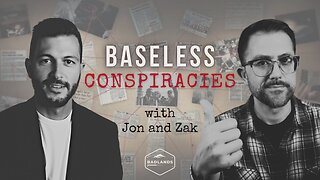Premium Only Content

75. Dr Robert Chandler and the death signal.
Today I speak with Dr. Robert Chandler. He discuses that he and his team have been seeing as they research the harm associated with the jab. He has made a website where you can see the pathology slides that he and his team have been able to review. This way you can see for yourself. https://robertchandler.substack.com/p/histopathological-reevaluation-of robertchandler.substack.com
I use Harvest Right Freeze dryers. I am an affiliate and do get a percentage if you use this link:
https://harvestright.com/
I truly believe in their products and have owned a Harvest Right Freeze Dryer since 2016. It is the best way to ensure you have food for you and your family.
As always please like, share and follow. Please check out my Patreon account (https://www.patreon.com/Afterhourswithdrsigoloff). This is mostly to help with the legal fees. Please consider contributing but if you are unable to donate money please give prayers.
truthforhealth.org for COVID illness and long haulers syndrome treatment protocols. If you have a vaccine injury (from any vaccine or have any injury that you think may have any relation to any vaccine) please report in their civilian equivalent to VAERS.
Patreon: https://www.patreon.com/Afterhourswithdrsigoloff
Email: [email protected]
Telegram: https://t.me/afterhourswithdrsigoloff
Instagram: @afterhourswithdrsigoloff
Clouthub: @DrSigoloff
TruthSocial: @DrSigoloff
Rumble: https://rumble.com/c/AfterHoursWithDrSigoloff
Youtube: https://www.youtube.com/channel/UCQ_ng3WYVhnctCYq6Rom07g
Givesendgo: https://www.givesendgo.com/G37EN
Please check out a friend and his custom products.
Flag Sign and Tumblers
themustardseedshop.net
https://www.facebook.com/groups/themustardseedshop/?ref=share
75. Dr Robert Chandler
===
Nurse Kelly: [00:00:00] Welcome to after Hours with Dr. Sigoloff, where he can share ideas and thoughts with you. He gets to the heart of the issue so that you can find the truth. The views and opinions expressed are his and do not represent the US Army, d o d, nor the US government. Dr. Sigoloff was either off duty or on approved leave, and Dr. Sigoloff was not in uniform at the time of recording now to Dr. Sigoloff.
Dr. Sam Sigoloff: Hey, well thanks for joining me again. I want to give a special shout out and thank you to all my Patreon subscribers. We've got Shell pace at the $50 level, Sam and Angela Sheey at the Self-Made 2020 level. We have the Pandemic Reprimand, that's $17 and 76 cents a month.
Dr. Sam Sigoloff: And we have Tide Reid. We have Charles Allen, we have Tinfoil, and that's obviously a screen name. Stanley Williams, doctor Anna Mahaka Frank Dip. We have a self-made $10 level with Kevin aos. We have the refined, not burned at $5 with Linda Emme [00:01:00] Joe, pat and Bev, pj, Rebecca, Marcus, Elizabeth, Dawn, and then the courage is contagious.
Dr. Sam Sigoloff: That's $1 a month with Amanda. Jay Spitz, nasty. And Darrel, thank you so much. For, for helping support me. It truly means the world. It means more than the dollars than than you can ever imagine. The guests that I have today, I have a pleasure of introducing Dr. Robert Chandler. Now, Dr. Chandler is a retired orthopedic surgeon.
Dr. Sam Sigoloff: So he has had some more time than the rest of us to sit around and look deep into this, this information that we're about to go over here. Now, he's been working with Daily Clout. He's been with Team Five and now working with Team three on decoding all this information and figure out what, what are the safety signals that we're seeing now, sir, thank you so much for com coming on.
Dr. Sam Sigoloff: Please call me Sam throughout this cuz it's just easier.
Dr. Robert Chandler: Will do. . So where do you wanna start first? Well, I I think probably where we usually start trying to understand disease [00:02:00] processes, which is the pathology and the histopathology. Just, just as little background pathology is, is understanding how disease impacts cells and tissues.
Dr. Robert Chandler: And histopathology is looking at the cellular level. And recently Dr. Burkhart, who is a pathologist, retired pathologist in Germany began receiving this was in 2021, I believe. Consultation cases, forensic consultation cases brought to him by family members who had lost loved ones and had had autopsies performed on the deceased loved ones, but were not satisfied with the results of the autopsy.
Dr. Robert Chandler: There was something unusual about the cases that drove them to, to Juan Autopsy. But then when the autopsy was completed, most of the time they didn't have a cause of death. Sometimes they said natural causes, to which Dr. [00:03:00] Burkhart said, I, I don't know what a natural cause is. We need to dig deeper, which is what he did.
Dr. Robert Chandler: He put together a group of pathologists beginning with a faculty member at the University of Hanover in Northern Germany. And now he has a group of 10 pathologists physicists, biologist, and they're trying to get to the bottom of what these strange new diseases are. He first presented the results of 30 autopsies plus three biopsies December of 2021.
Dr. Robert Chandler: He repeated it in February of 22. And I took that information cleaned up the voice transcribed script and feathered in the 60 some odd photo micrographs. And basically what he's done is outline the pathologic basis of vaccine disease. And he's just recently at a meeting in Stockholm [00:04:00] updated the series with now a hundred autopsies in 20 biopsies, which is probably the world's biggest study of underlying pathology to the harm's caused by these vaccines.
Dr. Robert Chandler: And the second lecture or the second lecture series. I've now prepared in a text form, which should be available today or tomorrow on daily cloud. So you'll have a hundred page document with about 150 photo micrographs of histopathology from people that were being investigated as having died from vaccine related etiology or cause, which he determined to be present in about 80% of the cases he's looked at.
Dr. Robert Chandler: And I think that's a good place to, to begin trying to understand what these products are actually doing in the human body. Now,
Dr. Sam Sigoloff: sir, when you say vaccines [00:05:00] you're referring to specifically only the, the covid shots?
Dr. Robert Chandler: Yeah, I should have clarified that the, the term vaccine we try to avoid, it's really gene therapy.
Dr. Robert Chandler: And what doc Dr. Berkhart found was all four manufacturers producing similar kinds of complications, whether it's a vectored or it's a mRNA product.
Dr. Sam Sigoloff: And I want to drive anyone's attention to what, what you just mentioned is how you, you're using an nomenclature that everyone knows. So we know. So it's a familiar language, right?
Dr. Sam Sigoloff: So we say vaccine, but in the professional sense, he doesn't use the word vaccine, neither do I, because it's not a vaccine, it is a gene therapy. And I actually got a I was allegedly ordered and there was a command 15 six investigation against me to see if I disobeyed a direct order to not call it a gene therapy.
Dr. Sam Sigoloff: Well, . You can't tell me what to say and what not to say. It's a first amendment right, and gene therapy is the best explanation for what this type of shot is. But I, I just wanna draw attention to that because I [00:06:00] think that's an important point that when to help you discern, help a listener and the viewer discern that when there's someone who's talking and they're not willing to call it a gene therapy or they're not willing to use other nomenclature that I've discussed then maybe there, there could be two things.
Dr. Sam Sigoloff: They could be, they, they're still living in this kind of cloud or they have other influencing factors.
Dr. Robert Chandler: Well, I, I, I think this whole thing about this focus on definitions and words, it's, it can be distracting. Clearly these products have a different mechanism of action, what you call it the nomenclature.
Dr. Robert Chandler: We, we can argue about that, but I don't, I don't think we can argue about the substance of the issue that you have a genetic code that's injected into your body. It commandeers your body's cellular machinery to produce a foreign protein. So that is gene [00:07:00] therapy. It's not a traditional vaccine.
Dr. Robert Chandler: Traditional vaccines generally came in two forms. One was a killed virus, and the second was attenuated virus. And that constitutes all prior to these products, the nature of vaccinations.
Dr. Sam Sigoloff: And that definition that you just gave of gene therapy that was actually defined by the FDA in 2018. So it's not something new that we've changed, it's something that they've changed the definition of vaccine, not the definition of gene therapy, which is important.
Dr. Sam Sigoloff: And thank you for, for discussing that point.
Dr. Robert Chandler: Yeah, and, and it has implications too because the approval process varies according to whether you're dealing with a gene product or a traditional vaccine with the gene products being much more detailed and, and exhaustive. And there's a lot we can't deal with in terms [00:08:00] of motivations and why people did things.
Dr. Robert Chandler: But it certainly bypassed some of the safety mechanisms involved with product development.
Dr. Sam Sigoloff: Sorry for, sorry for that destruction. I just think they're really good points that, that you're bringing up.
Dr. Robert Chandler: I don't know if it was you or me, , it's a new platform,
Dr. Sam Sigoloff: but what were some of the things they were seeing in the autopsies that you've dove headfirst into?
Dr. Robert Chandler: Yeah, it's, it's a very intense experience and let me just give your, your listeners and, and viewers a a little assistance. The, the papers that I've put out are available on my sub and it's free.
Dr. Robert Chandler: It's not meant to be fundraising. This is pure information. So my sub is just Robert Chandler dot.com and you'll find the first edition of the Burkhart series [00:09:00] on that. It's also part of the Daily Clout Library daily clout.io and under the Pfizer documents analysis. And you'll see, I think we're up to 57 reports, and this is number 56.
Dr. Robert Chandler: And what, what encourages the reader listener, viewer to to how, how to approach this as a visual experience. It's not like reading a chapter in a book or an article on magazine or newspaper or even something you might see online. Now this is visual and in that first paper there's some 60 photo micrographs.
Dr. Robert Chandler: Have a look, get a, get a sense of the gestalt. I've embedded a tool called histology guide.com, where you can pull up images of normal tissues if you want to compare and go through the slides. And you'll [00:10:00] see that Dr. Burkhart and his group in Germany have done a very nice job of identifying specific forms of pathology associated with these genetic therapies.
Dr. Robert Chandler: Let just outline some of them. One of the fundamental things that happens when this materials inject in your body is you start making foreign proteins. And those proteins sometimes called spike, and it seems like there's a group of them. It's not just one. Have a propensity to the cell lining of blood vessels.
Dr. Robert Chandler: And this is critical because blood vessels go through your whole body, so you, you can have involvement of many different organs. In some of the cases, Dr. Burkhart and his group looked at had up to five organ systems involved, and it's the vascular system that gives [00:11:00] access and entry of the spike TR protein that's produced by the mRNA that's injected along with the, the nanoparticles in, in this gene therapy.
Dr. Robert Chandler: And then the body starts to attack those spike proteins and if they're affixed to the wall of a vessel or if they're in an organ. You start seeing cellular accumulations that aren't normally present. Tissues, lymphocytes, in some cases, eosinophils, and associated with that process of infiltrating these foreign proteins.
Dr. Robert Chandler: You have damage to normal structures and the process is generalized, but the organ damage can be specific, so you can have conditions related to the heart, to the brain and pick the organs. I, I went through this slide deck and I found 12 different organs that were involved. So the manifestations are quite variable and could be [00:12:00] anything from autoimmune, which is the body attacking itself to disorders of blood both.
Dr. Robert Chandler: Excessive clotting, coagulopathy or excessive bleeding. And there's also deposition disease sometimes called amyloidosis. Foreign proteins sometimes cannot be broken down by the body and start accumulating in, in tissues. There's some idea that Alzheimer's disease, for instance, is caused by deposition of foreign proteins.
Dr. Robert Chandler: And Dr. Bur berkhart is clearly identified amyloid like proteins aggregating in the tissues. One of the final mechanisms that's particularly disturbing is neoplasia. Neoplasia is the formation of new tissue. It can be benign, it can be malignant, and Some of the malignancies are, are very disturbing.
Dr. Robert Chandler: They can be multicentric primaries, meaning you don't just see cancer [00:13:00] in one cell type, but you may have multiple including blood cells like in lymphoma. And that is not perfectly delineated right now, but there is data accruing that suggests that these therapies are associated with particularly aggressive form of neoplasia, malignant neoplasia.
Dr. Sam Sigoloff: Yeah, that, that's interesting because a couple of the things that you've recently mentioned, so the clots and the cancers, and I, I really wanna draw attention to usually when you, when a person, let's say before 2019 we'll go back to 2018, just to have a wide, wide margins, if you will. . Yeah. But if we go back to 2018 and we look at cancer, when someone was developed cancer, let's say you found a metastasis far away, you could reasonably assume that that was the only type of cancer that you didn't have multiple different primaries.
Dr. Sam Sigoloff: And this idea of having multiple different primaries is very unusual. Typically, you get one type of cancer, not [00:14:00] multiple types of cancer in the same organ or in various parts of the body. And a metastasis was usually not always, you couldn't hang your hat on it, but you could usually say, yeah, that's probably from the primary that's over here, but we have to get a piece of the primary piece of the metastasis and make sure they're the same.
Dr. Sam Sigoloff: But now we're getting nets and primaries, and they're, they're different because it's from a different primary, which is mind blowing.
Dr. Robert Chandler: Yeah. How, how do you treat multiple simultaneous cancers that are aggressive? And I, I, I think it's something we need to start Thinking about in a fundamental way. And, and I think that's the significance also of Dr.
Dr. Robert Chandler: Burkhart's work is autopsy histopathology molecular analysis can help establish causation, which is important in, in many other respects, but it also starts pointing the way to treatment. And one of the encouraging thing that's happening even in this climate of censorship, and [00:15:00] my God, my God, you've gone through incredible experience.
Dr. Robert Chandler: Try, trying to speak your mind. And science and medicine are about debate and resolution. Sometimes it takes years. To, to get to a conclusion, but we can't afford to put this off the, these medical maladies associated with this treatment. We just need to jump on this and use the pathologic basis of the disease to start designing treatment.
Dr. Robert Chandler: So let me give you an example of that. For instance there, there are some medications, some, some drugs that come from other uses that look like they can disable the spike protein which be terrific because some people don't seem to be able to shut down this manufacturing of spike, at least for six months.
Dr. Robert Chandler: Dr. Berkhart now has a case that showed up at eight months. [00:16:00] And shutting down spike by basically recycling it with one of these products can, can help relieve that set of illnesses that, that flow from this Mr. mRNA lmp set of products. Yeah. And
Dr. Sam Sigoloff: I wanna talk about the clots and then go back to the rna, but the, the clots that we've been seeing with these, have y'all have y'all had any slides of, of clots to look at them under the microscope?
Dr. Robert Chandler: Yes. And not the first Burt series, but the, the second one that's should be up on daily clout today or tomorrow. Amy is working hard. There's 106 images. The file is 479 megabytes. So it's richly illustrated. She has to hand process each one of those images to get it up, but we want the public to be able to jump [00:17:00] into this material and understand what we're facing as a society and, and as a species.
Dr. Robert Chandler: There's over 5 billion people that have this product in their body. I think this is something we've gotta get past the censorship and, and all of this kind of stuff and start working together on some solutions.
Dr. Sam Sigoloff: Yeah, because one thing I'd be very interested in is seeing the these fibrous clots under a microscope and compared those to the, the current jelly clots or the fat clots that we have seen in the past.
Dr. Sam Sigoloff: And that kind of ties into an episode that I did couple episodes back with Tom Halan and how he, he reached out to some embalmers to find, just to do a survey to see if they've been seeing these new fibrous clot.
Dr. Robert Chandler: Well in, in the second set of berkhart documents. There, there is some, some work that he's done on that.
Dr. Robert Chandler: And, and it's quite informative. This does not appear to be the standard fibrin clock that we're accustomed to [00:18:00] it. It may be chemically different and, and mechanically different. So it may require different treatments. First we have to recognize it. We have to diagnose it before it gets to prolong.
Dr. Robert Chandler: But it appears that this material which could be amyloid and, and Dr. Burkhart's second set of. And, and the hundred six I'm talking about are all, all new. So we've got a, a library now of 150 histopathology. It's an excellent basis to understand how this set of diseases functions. He, he starts examining some of that clot material, and it looks like there's Ms.
Dr. Robert Chandler: Amyloid these abnormal proteins that are part of that they call it clots, but I'm not sure that nomenclature's gonna stick. There, there's also debris Call it debris. It's the chemicals that surround the messenger rna, the lipid nanoparticles, which have some chemicals that look like they aggregate in vessels.[00:19:00]
Dr. Robert Chandler: So it's not just the mRNA, but it's the lipid nanoparticles look like they have an influence in disease states and, and could possibly, I have a role in altering the clotting mechanism and, and the nature of the clot. There's an electron microscopy of lipid, nanoparticle induced abnormal clots, and it just looks different structurally.
Dr. Robert Chandler: It to me, as an orthopedic surgeon, I, I would wanna know if there's collagen in that material or collagen like substance that would be resistant to traditional vascular degradation processes that clear clots from your blood system and maybe that these aggregations are going to require different form of treatment
and, and not,
Dr. Robert Chandler: well, I, I just wanted to finish and say traditional form of treatments would be things like [00:20:00] using heparin which yeah.
Dr. Robert Chandler: Tpa streptokinase, things of that sort.
Dr. Sam Sigoloff: In, in your experience being a orthopedic surgeon, right? Because to give people little ideas, you usually have to put a tourniquet on someone's extremity before you do a total joint. In that way, all the blood's cut off. One thing that, that you never wanna see is a, a deep vein thrombosis which would be a clot in a vein, but in all your years of practice prior to 2018, again, we're getting those wide margins.
Dr. Sam Sigoloff: Had you ever seen a clot in a artery?
Dr. Robert Chandler: Rarely. Most of that work would be done by vascular surgeons and, and clots coming from a venous side or, or more problematic for orthopedic surgeons as a complication for hip replacement. As you pointed out not so much with the tourniquet and maybe what people don't understand. Is that we routinely use tourniquets in orthopedic surgery.
Dr. Robert Chandler: That gives us a bloodless field so that we can go in and rearrange [00:21:00] structures and try to repair things without having to deal with bleeding that's associated. So we commonly will inflate a tourniquet to 200, 2 50 millimeters of mercury for up to two hours. And that's probably a concept that's a little foreign to people operating in a bloodless field because of a tourniquet.
Dr. Robert Chandler: You know, it's just doesn't seem right, but we do it all the time.
Dr. Sam Sigoloff: And then one other thing that I wanted to mention is the rna. You had mentioned that y'all have measured them at, I think as you said, six and eight months. Have you read anything about the modified mRNA where they're not using native type of rna, but they're, they're.
Dr. Sam Sigoloff: They're modifying the nucleic acid so that it doesn't get broken down by your body.
Dr. Robert Chandler: Yes. You know, we, we were told that this and it's actually in the Pfizer document confidential document, 2.4, where they say this mRNA is broken down in 1224 hours. Normal degradative [00:22:00] processes, which is really strange because in the same document, 2.4 they have documentation, then it goes on for the duration of the animal study, which was 48 hours.
Dr. Robert Chandler: And it was still circulating. In fact, it was, and many Oregon systems was still accumulating on an ascending pattern. It was or still rising so clearly it, it exceeded what the designers told the public that this stuff would be in your body and gone. And then you just have the benefit from the antibodies produced in the cellular immunity.
Dr. Robert Chandler: It turns out in reality, they've hardened this molecule. They've hardened it to degradation. It's got a stealth aspect so it can come into your body undetected. And in order to do that, they created an artificial nucleus side. Now, I think your audience may know [00:23:00] that mRNA is built of a series of four molecules that are linked together on a phosphorus backbone, kind of like a string of pearls, but one of those four molecules, the nucleosides or nucleotides, if it's built into the chain, one of those nucleotides is synthetic.
Dr. Robert Chandler: It's never been in the human body, and it's one in methyl pseudo uridine. And what's the implications of that? Are I, I'm still scratching my head over what happens if you take a computer code, for instance, which is what mRNA and DNA really consists of. It's a code that programs yourselves. And you introduce an artificial string of code that you don't know exactly what it does other than it's meant to prolong the existence of the mri, which it does quite well.[00:24:00]
Dr. Robert Chandler: And studies that go out as far as 60 days find that this mRNA is still working in cells producing spike protein. So this modification just needed more analysis to, to understand the, what we call the pharmacokinetics, what happens to it, toxicity additional studies.
Dr. Sam Sigoloff: And, and that's one thing that if Sherman, the listeners and viewers have, have noticed this, that Dr. Malone, yes. He, he claims to have, he, he says that he's the one, the inventor and has a lot of patents for mRNA. But that was for messenger RNA mRNA, not this kind of pseudo mRNA, which is actually MOD rna. When you look at the Pfizer documents, it says mRNA has a asterisk next to it. You look at the bottom of the page and it says modified.
Dr. Sam Sigoloff: And they modify the nucle nucleic acid
Dr. Robert Chandler: and, and modified it to, to last to be durable. So on the one hand, they're telling us, well, it's gonna be de degraded naturally, but they've engineered the product not to be [00:25:00] degraded. Figure that one out.
Dr. Sam Sigoloff: And have you been able to find, or have you looked at the lipid nanoparticle as a toxic toxic to human bodies type of substance?
Dr. Robert Chandler: Yes. The, there's big question is to what's actually in these bottles and there's been no detailed analysis. We, we can look and, and let's say the document 2.4, for instance, in the Pfizer confidential documents, they list the contents. In addition to the mRNA there's a number of other elements.
Dr. Robert Chandler: One is polyethylene glycol, which has an allergic profile. It can cause particularly severe form of allergy called anaphylaxis. But there's another product that's cryptically referred to as a L c dash 3 0 3 15. And I tried to find out about that. And [00:26:00] I just couldn't get very far in terms of its biocompatibility aspects.
Dr. Sam Sigoloff: And what's interesting about alc 0 3 15 and there's another a L c zero, I can't remember the name at the moment, 1 59. And, and there's a third lipid nanoparticle that's also in Pfizer. And that was the basis for the medical exemption that I was writing for service members that wanted to be exempt from getting this shot.
Dr. Sam Sigoloff: Because if you look up the safety data sheets on those three products the ALC ones, those say they're not validated for medical use. And that all safety ends up is the responsibility of the end user. And here we are injecting it into people. And then the DSPC or dsp, whichever one it was that one says it's not validated for veterinary use, but here we are injecting it into people.
Dr. Robert Chandler: Yeah. with classified toxicology. He seemed reckless, very reckless . Yeah. Yeah. I, you know, Sam, my background as a surgeon, [00:27:00] vaccines were of little interest in, in fact, I, I took everyone I could get. I had three friends that died from getting hepatitis in the operating room. Yeah. So gee, I was anything but an anti-vaxxer and it wasn't until I had Moderna two and developed a fever 104 degrees.
Dr. Robert Chandler: I said, wait a minute. , this, this isn't, there's something wrong here. Which was one of the motivations for me to dig into this and, and being retired and having a background in molecular genetics. A little bit strange for orthopedic surgeon, but I studied biology at Stanford and had two Nobel laureates as professors molecular genetics Nobel Prize winners.
Dr. Robert Chandler: Certainly the field has evolved massively since that time, but I'm not, not intimidated by this stuff, and I, I'll dive in and look at it. So that's kind of how I got into this and when this set of documents was released. And, and thanks to Aaron Siri at ican for getting these documents out.
Dr. Robert Chandler: And started [00:28:00] looking at it, I said, whoa, I can't, I actually can't believe this has happened. You know, I, I came through medicine at a time when the C d C and the FDA were on a pedestal journals like Lance at New England Journal. It, it was gospel and it was the guiding light in, in medicine. And once I started looking into it, I, it's more than just a vaccine issue.
Dr. Robert Chandler: It's what's happened to medicine and science.
Dr. Sam Sigoloff: Well, I think one thing is if, if you weren't able, if you didn't have the time, which most of us doctors weren't, especially as a surgeon, you're spending your time doing work with your hands, not, not reading the stuff that you need, that the medicine that's not that important to you.
Dr. Sam Sigoloff: And as a family med doc, I was swamp seeing patients. And so never have time to look into any of this stuff. And then now that we have all this time on our hands and there's this huge, just glaring hypocrisy and just Evilness, I don't really have a better word to describe it of what's going on in these organizations.
Dr. Sam Sigoloff: Then you're like, well, let me look back and let me read more about everything that I thought I ever [00:29:00] knew, like statins and I mean, just everything.
Dr. Robert Chandler: That's right. Yes. And, and I think we need to do that. And I've suggested at Daily Clout now that they have these teams that are functioning. You know, I was in academic medicine for a while and actually have more resources at Daily Clout than I had at a major university.
Dr. Robert Chandler: If I want some statistics done I can fire that off. Right now, one of my colleagues is reviewing the histology because of what I've tried to do with the Burkhart two, if you will, is to guide the eye a little bit by circling and putting arrows. So people are, are drawn to the pathology that's meant to be illustrated.
Dr. Robert Chandler: And Dr. Flowers is part of my group part of my team here. He's going through to make sure that, that we're showing things clearly and accurately, which, which is pretty incredible. And it gets done fast. We, we can crank these things out have each other, review them, [00:30:00] critique them, modify them in a relatively short period of time.
Dr. Robert Chandler: And yes, the practicing physician can't do this. I'll spend 50, 7500 hours on one article. The Shema paper that came out originally in April of 21 on pregnancy. I looked at it I've done peer review for 30 years. So I, I said, I'll do a peer review on this. So I started getting into it. I said, this does, it's not just peer, well, it's not, yeah, it's not just peer review.
Dr. Robert Chandler: I did a second follow up article, which I call forensic analysis which is almost impossible to read. Because of the machinations and obfuscation. And it's up on my, again, it's very difficult to read. I doubt if people get through it, but for a practicing physician to dissect that paper, good luck.
Dr. Sam Sigoloff: Yeah. I'm, I'm not the smartest man in the room, [00:31:00] but I had to go over that about four or five times and call up an ob gyn and sit there on the phone and talk with her and, okay. Explain this to me one more time, how you did this. So, so they actually just gave the wrong denominator to make it look like it's like a 10% pregnancy loss, when really it's an 82 and a or 81 point a half percent pregnancy loss rate. It's,
Dr. Robert Chandler: well, Sam, let, let me tell you what I, and again, I spent a lot of time on this in the first article, which was meant to be a peer review. I go into that calculation in great detail, and my conclusion is there's no numbers you can generate from this report, so that with all the resources, the federal government, 14 billion budget, they had no useful data in 2021 regarding pregnant women, which is astounding given there was no preclinical testing in pregnancy.
Dr. Robert Chandler: And I, I [00:32:00] just, I almost couldn't believe it. And I, I go through all of those machinations and steps with that publication. And, and I think we've put the two documents together. It's well over a hundred pages with fairly exhaustive look at how they presented that to the medical Medical public because busy doctors, you know, this, you, you trust the journal you trust the abstract to fairly reflect what's in the materials, methods, and conclusions.
Dr. Robert Chandler: You expect the conclusions to be supported by the actual data. You expect the data be transparent and accurately reported and this process is not working right and we've gotta fix it.
Dr. Sam Sigoloff: That brings me to the next thing I wanna talk about, cuz you talked about this on, on Daniel Horowitz, and I want to hear more about this, but you looked into how this affects men and women.
Dr. Robert Chandler: Well, phenomenal. [00:33:00] You know, when document 5.3 0.6 and sorry folks, these, these are cryptic. When, when you go on series website and you see how these documents were presented to us, You'll understand some of the obstacles that the teams that have gone through this have had to overcome and they're just cryptically displayed and there's tons of them.
Dr. Robert Chandler: I personally, I personally, have printed out 25,000 pages which is driving my wife nuts because this paper is all over the house. I had to buy second printer, so I used three computers, an iPad and two printers to, to output all this stuff cuz you have to, cuz it might disappear. You look at it once and it's gone when you go back to look at it.
Dr. Robert Chandler: So you better screenshot it and hard copy it. But the, the level of detail behind this analysis is, is impressive. And, and some of the teams working on this are, are just doing a phenomenal job.[00:34:00]
Dr. Sam Sigoloff: Can we get into some of the findings that, that you've seen so far with, let's say men and testes?
Dr. Sam Sigoloff: No, no, that, that, that's okay. Well, cuz there's so much to say about that five point, 3.6, like the, was it eight or nine pages of no space, single, you know, like maybe nine font of unusual it's, it's disastrous.
Dr. Robert Chandler: Well, I, unfortunately, I think that's intentional. So I took the time and I prepared, in fact, the most popular piece of my ck is I went through that document, 5.3 0.6 in a way that you don't have time to do and prepared a 24 page spreadsheet to make it transparent and it's all numbers.
Dr. Robert Chandler: and it's outlined on, on my, I think it may be in the daily clout archive too, where I try to make the actual data transparent so you don't have [00:35:00] to read through that horrible document. And there's some really strange things in that document. Like there's a footnote, it's dumb. Footnote number seven is way in the back in tiny font.
Dr. Robert Chandler: A very short sentence. It's something like a seven year old was injected and had a stroke. Wow. We need to know more about that seven year old. It wasn't released for children. What dose did this child get? And there was another cryptic note in that document that indicated a 28 day old baby was injected.
Dr. Robert Chandler: You think, what is going on here? Wh why didn't they stop it and say, well, what, we can't have this, and what's the outcome of those children? So one of the things we noted going through that document was the women just seemed to account for way too much of these adverse events. So we did a fiscal analysis.
Dr. Robert Chandler: We found that almost every category of disease had a female [00:36:00] dominance two to one, three to one. And the numbers vary, depend on which data set you look at, but it, it's, it holds, it holds across document 5.3 0.6. It holds against the document that came out of the TGA in Australia. There was about a million 1.3 or 1.4 million.
Dr. Robert Chandler: Huge dataset. Again, the females are two thirds of, of the adverse events, and we started breaking that category down. What kind of events are they having? Well, 16% involve the reproductive organs. And now we can go back to document 2.4, which tracks where this lipid nanoparticle encapsulated mRNA goes in the body.
Dr. Robert Chandler: And by gosh the ovaries are in the top four. So this stuff concentrates in the ovaries maybe accounts for this sex difference in adverse [00:37:00] events. And then we started looking at birth datas. And this is a separate report, and we found that there's a major decline in births in Europe, in north America.
Dr. Robert Chandler: And in, in oh, we looked at Taiwan. We looked at a number of different countries. It looks real. In Dr. Burkhart's second series, he has no ovarian or uterine specimens, but he shows that in the testes spike affixes to the mature, maturing sperm cells and decimate the popul. And I put in the document that's set to be released later today or tomorrow normal.
Dr. Robert Chandler: So you can compare, you can see how the sperm cells are just depleted in, in the testes. So even though the concentration in testes is nowhere near what it is in [00:38:00] ovaries, it has a profound effect on the germination or the maturation of sperm cells. And we know from a study done in Israel that sperm counts and the viability of the sperm are harmed for at least six months.
Dr. Sam Sigoloff: Is that as long as the spike protein is present? And do you, is there any way to determine like one spike protein damage is, you know, 50 sperm, or does it have to bind to it? Does it just mean in proximity? Is it. I don't even know what question to ask.
Dr. Robert Chandler: Yes. Well, I think there's, well, no, I got your question.
Dr. Robert Chandler: may maybe, cause my thought is the same. The words didn't work, but the idea does and, and I think it's a direct toxicity. There was a paper out of San Diego, I think it was Scripps that showed that there was a direct toxicity aspect to spike. But it also it's like you guys in the [00:39:00] army, you'll go light up a target and then artillery focuses in on it or f 18 flies over and, and hones in on that target signal.
Dr. Robert Chandler: It looks like the spike protein lights up tissue that then is attacked by lymphocytes and other blood cells that are meant to target covid. But the common feature is spike and they'll attack Spike wherever Spike is. So it appears to be a direct cellular attack on these germinating cells from activated lymphocytes, which I don't know if you've talked about the roskin study from Stanford, but they found mRNA in the auxiliary or the chest wall lymph nodes for 60 days producing from the mRNA producing spike.
Dr. Robert Chandler: And they had the opportunity to compare those germinal centers or lymph nodes [00:40:00] after the genetic therapies. The, these gene therapies compared it to actual covid at quite a different effect. In covid, these germinal centers are depleted and with these gene products, these germinal centers are activated and don't know if you accept the term angry white cells, but , it sounds like a political group. But you know, they, they take in basilic staining and, and gosh, to me that looks like they're premalignant. But talk about killer bees. And I think these things, and, and you have to put this together, you have to take the Stanford study and say, well, are these where these cells are germinated and then they accumulate as Dr.
Dr. Robert Chandler: Burkhart shows and these various tissues, is it a pitch and catch type of thing? And so we may have a whole different kind of lymphocyte, a hunter killer [00:41:00] lymphocyte that's targeted to your normal organs, which is something we better look at pretty quickly here.
Dr. Sam Sigoloff: You had said that Dr. Burkhart gave specific recommendations for women, women wanting to reproduce in the future. What, what were those?
Dr. Robert Chandler: Oh, I don't know if you're ready for this. Thinking. 5.3 billion people have been injected. Now think about this. He said, women, if you're planning to have a family, find a male who's not been vaccinated, so where are you gonna, where are you gonna find that?
Dr. Robert Chandler: It's profound. And you know, I think just, yeah, wa watching Professor Berkhart deliver this you know, he's 78 was born in Germany in 1944. Can you imagine what his childhood was like? And he was, he was retired. He's doing this outta [00:42:00] retirement. And I, I would say he's working probably as hard as he ever has.
Dr. Robert Chandler: So it's not a cavalier commenter.
Dr. Sam Sigoloff: No, no. And that's, it's, it's a hard thing to hear, but I think it's the things we need to hear and hopefully you saying that helps prevent a parent from giving that to their little. .
Dr. Robert Chandler: Well, let's be a little more clinical and therapeutic. You know, we don't, pathologists don't treat humans.
Dr. Robert Chandler: You do. I used to. Right? Thank God. It, it, professor Berkhart put a a cartoon at the end of his talk. Is is a doctor talking to a patient saying, well, sir, looking at the, your, your disease here, I'm gonna refer you to a pathologist. Well, it's meant to be humorous, but the, the point I think is I don't think we need to be overly negative.
Dr. Robert Chandler: I think there's room for an optimistic view that not [00:43:00] everybody has problems with these drugs. Some physiology may be able to defeat it. And I think we can develop treatment for, for many of these things, we just, we just need to get past the censorship and all of the nonsense that's going on in the medical field, in the field of science.
Dr. Robert Chandler: Look, folks, we get, we gotta work together on this. I don't care whether you voted for Biden or whoever, just put down the swords and the axes and quit the battle. Let's work together and solve this problem, and whoever's doing the censoring out there, please stop. Just please stop. And that's from my heart.
Dr. Robert Chandler: I have, I have to take a break from looking at this stuff. I, I've got this was a four part series for me. So part two is coming out part three. I've gone and gathered a bunch of case reports to say, [00:44:00] oh, the criticism's gonna be, oh, Dr. Burkhart, you know, he's blah, blah, blah. Well, okay, now I've got independent publications from many countries around the world showing similar findings.
Dr. Robert Chandler: So let's get past whether this is real or not, please. But the, the next step is how can we get to treatments, diagnosis, and treatments? And I think there's real progress being made there. It, it's not entirely public and, and you realize, Sam, that it's hard to bring this up in a public forum because whatever's happened to our ability to reason critically and negotiate the differences we have in, in medical ideas.
Dr. Robert Chandler: Let me just give you an example. In orthopedics, in the decade of the eighties, we came into a whole new set of techniques for fixing a broken leg. Seems mundane, but we had plates and we had nails, and we had casts and [00:45:00] braces, and we'd go to meetings, and then the brace guys would come in and fight and argue, and it was done in a collegial.
Dr. Robert Chandler: Yeah, you take your best shot and at the end of it you shake hands and, and you go back to your institution. You gather data. Let me just give you the, the, the quick and dirty on this. We ended up at the end of it all saying by gully, we got all these methods that work. We just have a full toolbox. What you have to do is learn when to use which one and how to do it properly.
Dr. Robert Chandler: And by golly, we can offer people all kinds of different treatments, not because one won the contest because we decided we knew how to use each one specifically.
Dr. Sam Sigoloff: Right. I think you're absolutely right in everything you're saying. I think the first thing we need to do is get the people to quit taking these things and putting them in their bodies until we can get the government to collect them up and take them [00:46:00] outta circulation.
Dr. Sam Sigoloff: And then the next thing. . Yeah. Stop 'em immediately. Stop these shots immediately. And then the next thing is cause I know this sounds like a lot of doom and gloom but you know, miraculously, the guy, the God of the Bible has made the human body in such a way that it can overcome things that you would never imagine It could.
Dr. Sam Sigoloff: Whether it be figuring out how to overcome these things, or it just, the, the mechanisms inside the body can, can wall bad things off and keep bad things from happening in the future. But either way, we need to have more heads come together, have more freedom to speak, and we can, we can build bridges to fix these issues.
Dr. Robert Chandler: That's right. I, I, I think we, we can beat this, but we got, we gotta change how we're working. Just, just to give an example, and I'm not a urologist or immunologist, but my mentor at Northwestern Medical School was Phil Patterson spent his life studying a condition of brain disease encephalitis that [00:47:00] he created laboratory animals by removing brain tissue, modifying it, injecting it back, and these animals will reject their own brains.
Dr. Robert Chandler: It's called experimental autoimmune encephalomyelitis. Well he did that to study the process. So we were attuned to autoimmunity at Northwestern, and on the ward we identified a young lady that came in with something that looked like Epstein Bar mononucleosis. It turns out that she didn't have some of the classic clinical features, so we worked her up.
Dr. Robert Chandler: The reason for admission was hemolytic anemia, Sam, and cold activated hemog hemolytic anemia, which in Chicago in the wintertime, it's, it's gonna become obvious. So she, 23 year old girl started destroying on red cells. And what we found out was she had cytomegalovirus mononucleosis, not epstein bar mononucleosis.
Dr. Robert Chandler: And this virus had gotten in and modified the type of red cell proteins that were [00:48:00] on the red cell wall and had changed the genetic instruction in the maturation of the red cell to produce a fetal antigen on the outside of the red cell. And she's 23 years old. She's got these fetal red cells in circulation that are attacked by her own body, which is where her red cells were going.
Dr. Robert Chandler: Well, it turns out the follow up on that she, she was treated, I think they treated her with steroids and the follow up was it resolved. Ultimately her body was able to overcome that reprogramming error caused by cytomegalovirus.
Dr. Sam Sigoloff: That's, that's wild. One thing I wanted to ask you, we haven't talked about that yet, was the brain. Cuz I remember early on thinking to myself, you know, Because the way we got the, this, the code of what the virus is, China put it up in some database and we were able to download it. We never actually had the virus in. You know, there's some people that say we still don't actually [00:49:00] have the virus, but that's a different conversation for a different day.
Dr. Sam Sigoloff: But my first initial thought was, what if someone hid inside of that code, the PreOn disease or cretz field yakka or mad cow in humans. And then I remember, not too much later I read an article by Bart Clayson where he says that the, the spike protein can induce, or at least theoretically can induce Cretz field yakka, which is mad cow in humans.
Dr. Sam Sigoloff: Have you seen any of those kind of those brain changes?
Dr. Robert Chandler: Yeah, and as I said, this is a four part series for me. The first part is Burkhart one number two is Burkhart two, which drops today or tomorrow. Number three is this accumulated series from the literature, and I'm gonna include those yakub, uhits disease and the discussion of amyloid in general because it has a role to play as we've talked about in the heart and in the blood vessels may be part of this clot as well as demyelinating disease was probably autoimmune deposition disease, which would be more like the Alzheimer's where, where [00:50:00] signals are just not processed.
Dr. Robert Chandler: So yeah, that's definitely part, part of the constellation of, of illnesses that these products seem to be responsible for.
Dr. Sam Sigoloff: Well, sir, I want to be respectful of your time. I, I truly appreciate you coming on and cuz we're, we're hitting right at the hour mark now, and that's all I I got you for is that hour. So I wanna be respectful of that. But thank you, thank you so much for coming on and sharing this information and I wanna leave everybody with a bit of hope that as long as we can speak the truth and we put out into the sunlight for all ideas to be exposed to sunlight, which is the best de disinfectant, all the conspiracy ideas will go away.
Dr. Sam Sigoloff: All the truth will rise to the top and we'll be able to figure out ways to overcome this.
Dr. Robert Chandler: Agree totally.
Dr. Sam Sigoloff: And where can people find your work sir?
Dr. Robert Chandler: My is Robert Chandler. One, one [00:51:00] word no spaces com. And the other is daily clout, one word, d a i l y dot clout dot io. And finally our first 50 documents are present on Amazon, the form of ebook.
Dr. Robert Chandler: It'll be out in a hard copy soon. I have to tell you, we're, we're well into volume two. And I would guess at the rate that we're preparing documents we'll have volume two done in the next six to eight months.
Dr. Sam Sigoloff: I'm gonna encourage the listener to get that book when it comes out on hard copy, cuz just like Dr. Chandler was mentioning earlier, these things disappear from digital sources. If it's, if it's not on your shelf, it's not actually your.
Dr. Robert Chandler: I plus, plus the people that say there's no evidence if you bring a 1500 page document and drop it on their desk and say, look at the, get back to me. Look it [00:52:00] over tonight.
Dr. Robert Chandler: Read, read through it, and we can go through it in detail tomorrow and should end at no evidence. Crap. Exactly.
Dr. Sam Sigoloff: Well, sir, I know it can be absolutely. Devastating, heartbreaking to be reading through these things, but I'm glad that you have stepped up to that challenge.
Dr. Robert Chandler: Yeah, thank and Sam, you know, I, a trauma surgeon, we used to, we used to train you guys in the army and, and we had a navy pilot that was orthopedic surgeon working with us at county usc, and I've seen some pretty grim things and, and you do certainly on the battlefield, but looking at these cases where you have a teenage.
Dr. Robert Chandler: Child that doesn't make it to breakfast. The parents go and find a dead child. I, I just had, I had to leave, I had to walk, came back and went to bed. I just, well,
Dr. Sam Sigoloff: I think, I think you said exactly what it is. It's, we're, we're in a battle, not a battle. We're in a [00:53:00] war. This is a bio bio warfare situation that we've been in since 27, March, 2020.
Dr. Sam Sigoloff: And now we're starting to see the casualties of that bio warfare and it's, it's children and it's, you know, football players and soccer players and, and it's grandma and it's grandpa and it's, you know, moms and dads. And it's devastating. And that's why these shots need to be stopped in. They need to be rounded up and we need to figure out what's in all of them because there's lot to lot variance and there's variance in each lot.
Dr. Sam Sigoloff: And they need to be, you need to store some for, for record keeping, but the rest need to be incinerated and destroyed.
Dr. Robert Chandler: Yes. I, I agree totally. We, this platform, and, and as I said, I was into molecular genetics 50 years ago with a couple Nobel Laureate professors, and I thought, whoa, this is just wonderful stuff, but it is just not going wrong right now. And we gotta step back and, and realize that reading some [00:54:00] of these studies, like the Stanford studies realize these people are brilliant, but this is a very complex area of medicine and we've learned enough to know how much we don't know yet.
Dr. Sam Sigoloff: And one thing that I just want to throw a caution out there for everyone is soon, someday you may see all the mRNA go away, and there'll only be normal, normal vaccines left. And if they still have lipid nanoparticles in them, do not take them. I truly believe that the lipid nanoparticle is the bio weapon.
Dr. Robert Chandler: Yeah, I, I haven't reached a conclusion because there's so many moving parts here. Looking at some of the basic science and then trying to put together the medicine, you may be right. know others have honed in on that too. And I'm, I'm just saying, look, I'm, we gotta keep everything on the table cuz we don't know what's in there. We don't know about the quality control. [00:55:00] There's been a lot of conversation about what these products actually do once they're in your, the body. And if you look at the gaps in the research and go back to the early part of this research effort, you say they just needed more time. They just needed to, to work on this. And someday it could be Tremendous asset to, to healthcare, but we're not there yet and we've gotta stop it and figure out what's happened and try to help the, the wounded get better.
Dr. Sam Sigoloff: Well, sir, thank you so much for your time today.
Dr. Robert Chandler: Thank you.
Dr. Sam Sigoloff: Just a reminder for everyone out there in duty, uniform of the day, the full armor of God, let's all make courage more contagious than fear.[00:56:00]
Dr. Sam Sigoloff: Are you concerned about having food for your family around the house? If so, check out Harvest Wright, freeze dryers, see if they're right for you. I've had mine since 2016. I absolutely love it. It's great. I can freeze dry food. The children love freeze-dried fruit. It gets so much sweeter than just regular fruit just by removing the water from it, and it can last for up to 25 years if stored properly.
Dr. Sam Sigoloff: Take a look at the link below and see if one of these is right for you.
-
 52:18
52:18
Dr. Sigoloff
1 year ago137. Cancer Doctor.com, with Robert Carrillo
2.29K11 -
 LIVE
LIVE
Badlands Media
9 hours agoBaseless Conspiracies Ep. 160
6,056 watching -
 LIVE
LIVE
Inverted World Live
5 hours agoTwo Texas Men Plotted to Invade Haiti | Ep. 146
2,191 watching -
 2:54:20
2:54:20
TimcastIRL
3 hours agoClinton Judge JUST DISMISSED James, Comey Indictment, Trump DOJ APPEALS | Timcast IRL
176K104 -
 LIVE
LIVE
SpartakusLIVE
1 hour agoCreator House LIVE STREAM || ASSUAGING the RAGE of viewers by streaming DEEP into the Night
289 watching -
 17:37
17:37
MetatronHistory
20 hours agoThe REAL Origins of the GREEKS
4.46K9 -
 1:19:32
1:19:32
The Daily Signal
6 hours ago $1.05 earned🚨BREAKING: James Comey & Letitia James NOT "Off the Hook" on Indictments, Sen. Kelly Court Martial?
1.42K -
 LIVE
LIVE
Drew Hernandez
21 hours agoBONDI DOJ BLOWS IT ON COMEY/LETICIA INDICTMENTS?!
846 watching -
 LIVE
LIVE
PandaSub2000
4 days agoLIVE 10:30pm ET | CARMEN SANDIEGO
159 watching -
 12:10
12:10
Robbi On The Record
1 day ago $0.12 earnedKarmic Disclosure and Predictive Programming
6.7K3